Works
The Steger Building, 28 East Jackson Blvd., Chicago. John Steger built this nineteen story skyscraper in downtown Chicago in 1910 to create a high-profile focus for Steger & Sons Piano Manufacturing Co. The building was the first high-rise building designed by Marshall and Fox and is today a designated Chicago landmark.
[6] Beginning in 1906, Marshall and Fox designed a series of buildings for the South Shore Country Club, the last of which was a large Mediterranean revival style clubhouse erected in 1916. This building still stands, and has been converted by the City of Chicago into the South Shore Cultural Center. The clubhouse is listed on the National Register of Historic Places. [7]
One of the firm's most noted works is the 1910 Blackstone Hotel, also on the National Register, along with the adjacent Blackstone Theater, now the Merle Reskin Theatre which was acquired by DePaul University in 1988 as part of their Loop Campus.
Other major buildings from the era include Stewart Apartments, the Drake Hotel, the Mayslake Peabody Estate (Oak Brook, Illinois), the Park Place Hotel in Traverse City, the Sheridan Trust and Savings Bank Building, and the Lake Shore Trust and Savings Bank Building, all in Chicago, plus the Schaff Building in Philadelphia, as well as the Edgewater Gulf Hotel and in Biloxi, Mississippi, a sister project to their Edgewater Beach Hotel in Chicago and the Fitzgerald Theater in St. Paul, Minnesota. The firm also designed Kaskaskia Hotel in LaSalle County, Illinois, and the Cobe Estate in Northport, Maine.
The firm designed many large and outstanding residences on Chicago's North Shore, including 681 Lincoln Avenue in Winnetka, IL and 615 Lincoln Avenue in Glencoe, IL.

Wilmette is a village in New Trier Township, Cook County, Illinois, United States. Bordering Lake Michigan and Evanston, Illinois, it is located 14 miles (23 km) north of Chicago's downtown district. Wilmette had a population of 28,170 at the 2020 census. The first and only Baháʼí House of Worship in North America is located here. Wilmette is also home to Central Elementary School and Romona Elementary School, both recent recipients of the National Blue Ribbon award bestowed by the U.S. Department of Education.
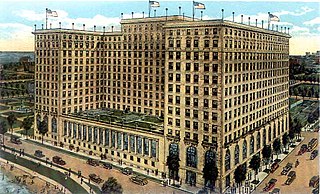
The Drake, a Hilton Hotel, 140 East Walton Place, Chicago, Illinois, is a luxury, full-service hotel, located downtown on the lake side of Michigan Avenue two blocks north of the John Hancock Center and a block south of Oak Street Beach at the top of the Magnificent Mile. Overlooking Lake Michigan, it was founded in 1920, designed in the Italian Renaissance style by the firm of Marshall and Fox, and soon became one of Chicago's landmark hotels, a longtime rival of the Palmer House. It has 535 bedrooms, a six-room Presidential Suite, several restaurants, two large ballrooms, the "Palm Court", and Club International. It is known for the contribution that its silhouette and sign on the lake façade make to the Gold Coast skyline.

The Edgewater Beach Hotel was a resort hotel complex on Lake Michigan in the far-north neighborhood community of Edgewater in Chicago, Illinois, designed by Benjamin H. Marshall and Charles E. Fox. The first section was built in 1916, for its owners John Tobin Connery and James Patrick Connery, located between Sheridan Road and Lake Michigan at Berwyn Avenue. An adjacent south tower building was added in 1924. The resort hosted famous movie and sports stars, and later Martin Luther King Jr. It was also the setting for the celebrity stalking case and shooting that inspired the novel and movie The Natural. The hotel buildings closed in 1967, and were soon after demolished.

The Blackstone Hotel is a historic 290-foot (88 m) 21-story hotel on the corner of Michigan Avenue and Balbo Drive in the Michigan Boulevard Historic District in the Loop community area of Chicago, Illinois. Built between 1908 and 1910, it is on the National Register of Historic Places. The Blackstone is famous for hosting celebrity guests, including numerous U.S. presidents, for which it was known as the "Hotel of Presidents" for much of the 20th century, and for contributing the term "smoke-filled room" to political parlance.

Graham, Anderson, Probst & White (GAP&W) was a Chicago architectural firm that was founded in 1912 as Graham, Burnham & Co. This firm was the successor to D. H. Burnham & Co. through Daniel Burnham's surviving partner, Ernest R. Graham, and Burnham's sons, Hubert Burnham and Daniel Burnham Jr. In 1917, the Burnhams left to form their own practice, which eventually became Burnham Brothers, and Graham and the remaining members of Graham, Burnham & Co. – Graham, (William) Peirce Anderson, Edward Mathias Probst, and Howard Judson White – formed the resulting practice. The firm also employed Victor Andre Matteson.
Schultze & Weaver was an architecture firm established in New York City in 1921. The partners were Leonard Schultze and S. Fullerton Weaver.
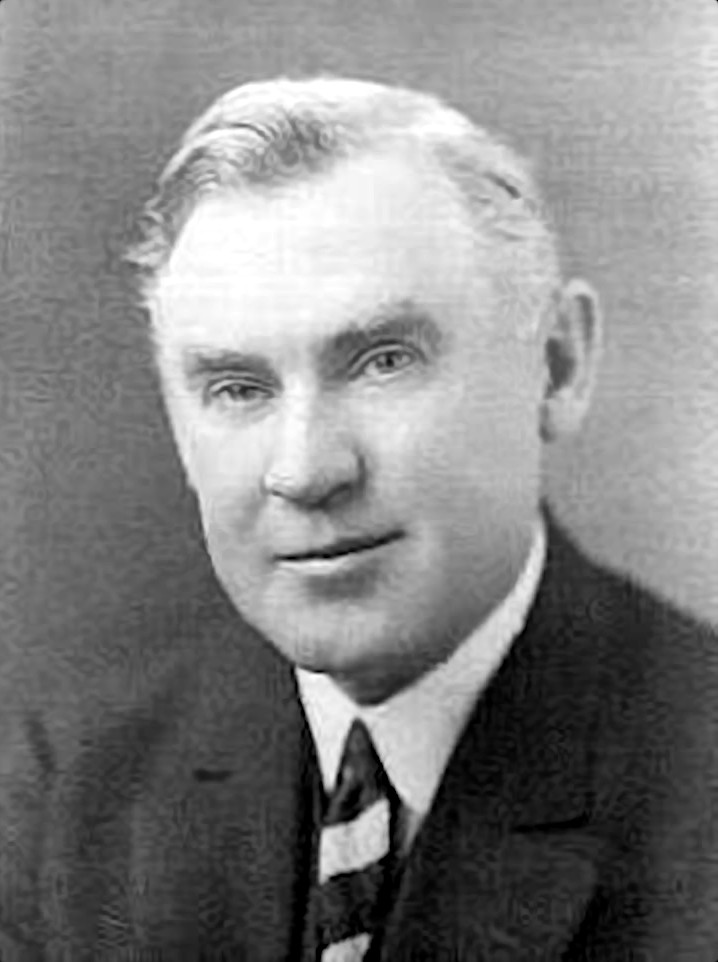
George Washington Maher was an American architect during the first quarter of the 20th century. He is considered part of the Prairie School-style and was known for blending traditional architecture with the Arts & Crafts-style.

The Merle Reskin Theatre is a performing arts venue located in the Loop community area of Chicago, Illinois. Originally named the Blackstone Theatre it was built in 1910. Renamed the Merle Reskin Theatre in 1992, it is now part of DePaul University, and is also used for events and performances of other groups. It serves as the home of the Chicago Playworks for Families and Young Audiences series produced by The Theatre School of DePaul.

Tracy C. Drake (1864–1939) and his brother John Drake Jnr. were the developers and proprietors of the Blackstone Hotel and Drake Hotel, which are both located along Michigan Avenue in Chicago, IL. The former is located in the Chicago Landmark Historic Michigan Boulevard District and the latter along the Magnificent Mile. Their father John Drake (1826-1895), was also a hotelier and the business partner of Timothy Blackstone.

John Burroughs Drake was a hotelier who was part owner of the Tremont House hotel in Chicago, Illinois. He managed the Grand Pacific Hotel from 1874–1895. His sons, John B. Drake and Tracy C. Drake were the developers and proprietors of the Blackstone Hotel and Drake Hotel, which are both located along Michigan Avenue in Chicago, Illinois. The former is located in the Chicago Landmark Historic Michigan Boulevard District and the latter along the Magnificent Mile. The Blackstone Hotel and Blackstone Theatre (now known as the Merle Reskin Theatre were built by his sons on the former site of the mansion of his business partner, Timothy Blackstone.
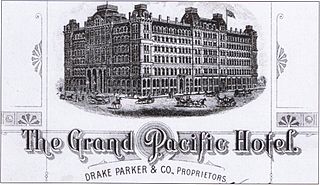
The Grand Pacific Hotel was one of the first two prominent hotels built in Chicago, Illinois, after the Great Chicago Fire. The hotel, designed by William W. Boyington and managed for more than 20 years by John Drake, was located on the block bounded by Clark Street, LaSalle, Quincy and Jackson. It was a replacement for the Paficic Hotel, which had been built in 1871, only to burn in the fire later that year.

The East Lake Shore Drive District is a historic district in the Near North Side community area of Chicago, Illinois. It includes eight buildings at 140 E. Walton, 179-229 E. Lake Shore Drive, and 999 N. Lake Shore Drive designed by Marshall and Fox and Fugard & Knapp and the opposing park. It was designated a Chicago Landmark district on April 18, 1985. These buildings include seven luxury high rise apartment buildings and the Drake Hotel. Note that neither of the buildings on either end of the district actually has an East Lake Shore Drive address. This district is located within the Streeterville neighborhood and overlaps with the Gold Coast.
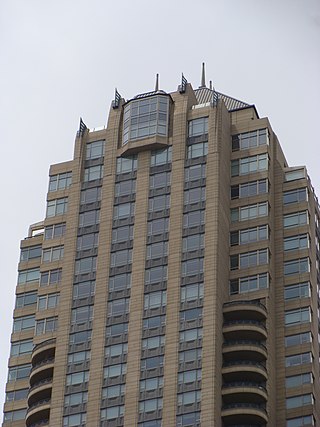
Lucien Lagrange is an architect and a former partner at Skidmore, Owings & Merrill, who founded his own firm, named Lucien Lagrange Architects in 1985. The studio is a representative of New Urbanism and New Classical Architecture.

Umpqua Bank Plaza is a 19-story office building in Downtown Portland, Oregon, United States. Faced with red brick, the structure is 263 feet (80 m) tall and has 265,000 square feet (24,600 m2) of space. Opened in 1975 at a cost of $16 million, the building was designed by Wolff, Zimmer, Gunsul, Frasca. Originally named the Benjamin Franklin Plaza after tenant Benj. Franklin Savings and Loan, the building was later renamed after current tenant Umpqua Holdings Corporation.

H. (Henry) Neill Wilson was an architect with his father James Keys Wilson in Cincinnati, Ohio; on his own in Minneapolis, Minnesota; and for most of his career in Pittsfield, Massachusetts. The buildings he designed include the Rookwood Pottery building in Ohio and several massive summer cottages in Berkshire County, Massachusetts.

Plaza del Lago is a shopping center at 1515 Sheridan Road in Wilmette, Illinois, United States, which opened in 1928 as Spanish Court. It has been reported as the second-oldest shopping center in the United States designed for automobile use, and the first such center in the state of Illinois.

Clarke & Howe was an American architectural firm from Providence, Rhode Island that was active from 1893 to 1928.
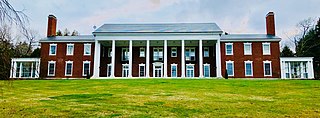
The Cobe Estate, also known as Cariad or Oak Hall, is a historic summer mansion house on Bluff Road in Northport, Maine. Overlooking Penobscot Bay, this 1910s mansion is one of the largest Colonial Revival houses in the state. It was built in 1912-14 for Chicago lawyer Ira M. Cobe, and was listed on the National Register of Historic Places in 1983.
The Marshall/Goldblatt mansion refers to a demolished mansion that was formerly located on the shore of the Wilmette Harbor in Wilmette, Illinois at 612 Sheridan Road. The exterior of the forty-room pink stucco structure was built in the Spanish Colonial Revival style. Built between 1922 and 1924, the mansion was among the most extravagant mansions constructed in the North Shore suburbs of Chicago and was considered an unofficial landmark. The residence was designed by noted architect and hotel magnate Benjamin Marshall and constructed as his personal residence and studio. Amid the Great Depression, the mansion was sold in 1936 to Nathan Goldblatt. The mansion became abandoned after Nathan Goldblatt's widow moved out in 1947. The Goldblatt family offered to sell it to the village of Wilmette's government to serve as a community center. This offer was rejected, and the mansion was town down between 1949 and finished in 1950. The land was then purchased in 1951 by the Baháʼí Faith organization, whose North American continental temple is located across Sheridan Road. Today, all that remains of the palatial mansion are a pair of gates along Sheridan Road.
John Augustus Nydén, was a Swedish-born American architect. Several buildings he designed are listed on the National Register of Historic Places. Nyden served as State architect of Illinois in 1926 and 1927.























